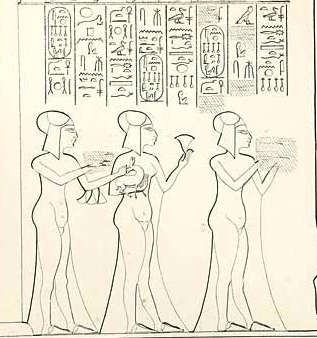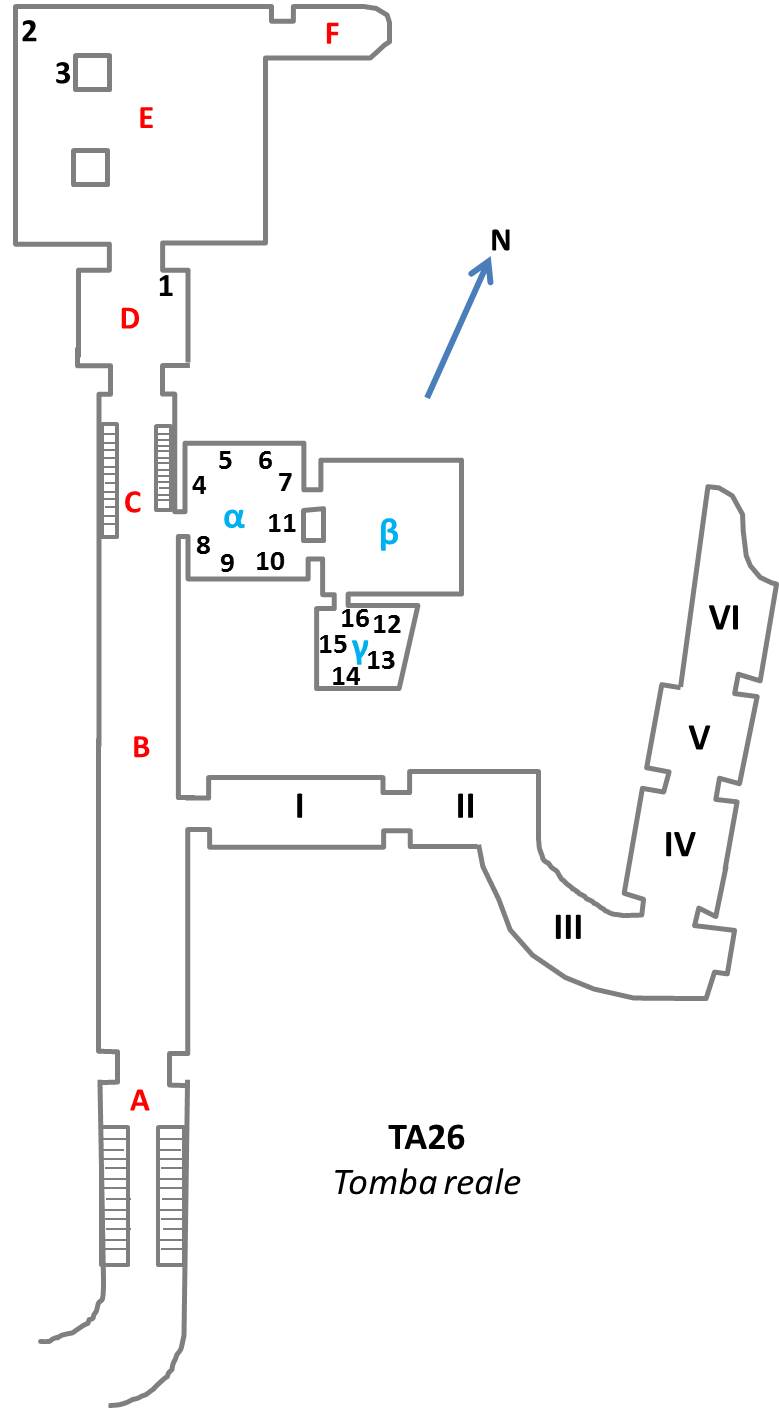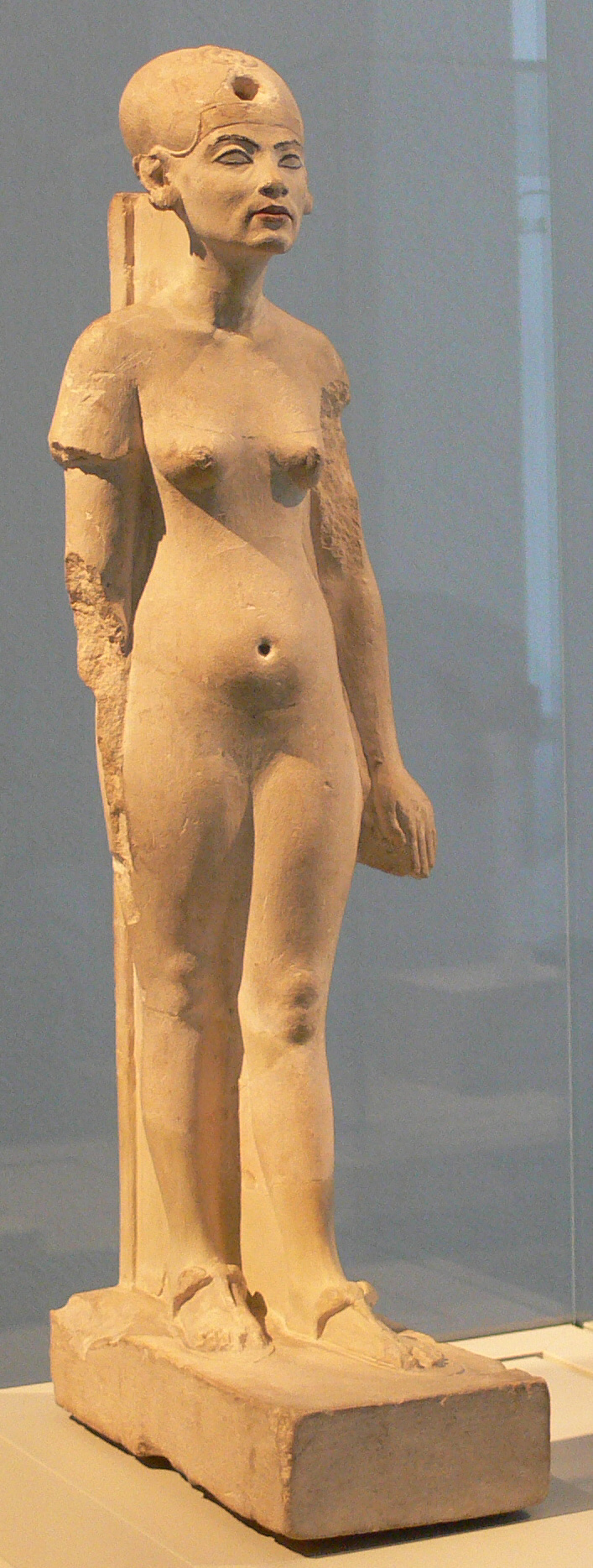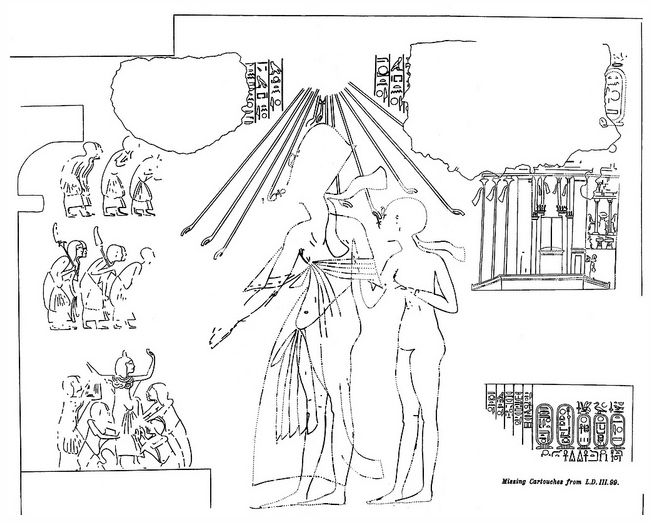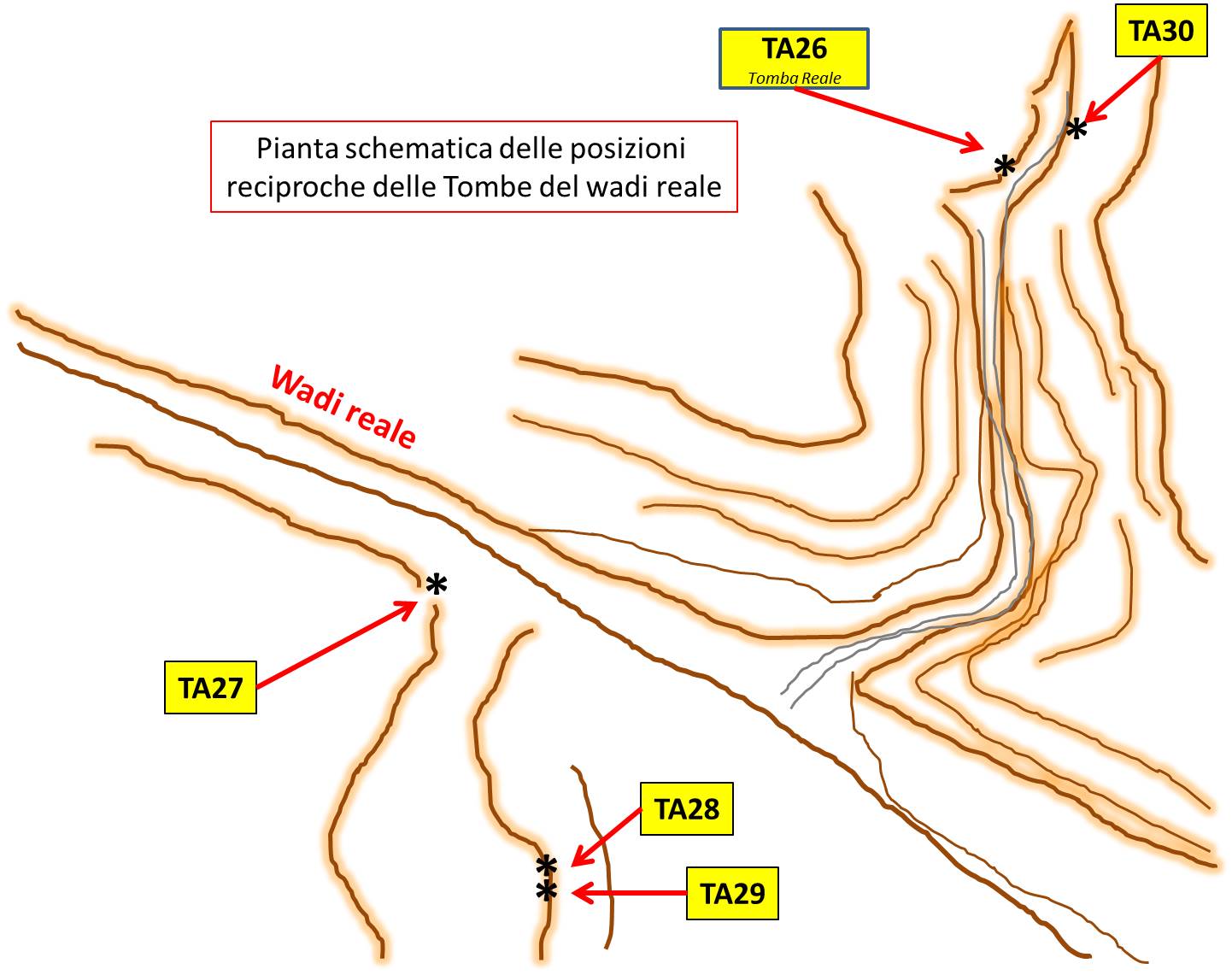|
Neferneferure
Neferneferure ( "beautiful are the beauties of Re") (14th century BCE) was an ancient Egyptian princess of the 18th Dynasty. She was the fifth of six known daughters of Pharaoh Akhenaten and his Great Royal Wife Nefertiti. Family Neferneferure was born during the 8th or 9th regnal year of her father Akhenaten in the city of Akhetaten.Tyldesley, Joyce. Nefertiti: Egypt's Sun Queen. Penguin. 1998. She had four older sisters named Meritaten, Meketaten, Ankhesenpaaten and Neferneferuaten Tasherit, as well as a younger sister named Setepenre.Dodson, Aidan and Hilton, Dyan. The Complete Royal Families of Ancient Egypt. Thames & Hudson. 2004. Life One of the earliest depictions of Neferneferure is in a fresco from the King's House in Amarna. She is depicted sitting on a pillow with her sister Neferneferuaten Tasherit. The fresco is dated to c. year 9 of Akhenaten, and the entire family is depicted, including the baby Setepenre. Neferneferure is depicted at the Durbar in yea ... [...More Info...] [...Related Items...] OR: [Wikipedia] [Google] [Baidu] |
Neferneferuaten Tasherit
Neferneferuaten Tasherit or Neferneferuaten the younger (, meaning ''most beautiful one of Aten – younger'') (14th century BCE) was an ancient Egyptian princess of the 18th Dynasty and the fourth daughter of Pharaoh Akhenaten and his Great Royal Wife Nefertiti. Family Neferneferuaten was born between c. year 8 and 9 of her father's reign. She was the fourth of six known daughters of the royal couple. It is likely that she was born in Akhetaten, the capital founded by her father. Her name ''Neferneferuaten'' ("Beauty of the Beauties of Aten" or "Most Beautiful One of Aten") is the exact copy of the name Nefertiti took in the 5th regnal year. ("Ta-sherit" simply means "the younger").Tyldesley, Joyce. Nefertiti: Egypt's Sun Queen. Penguin. 1998. She had three older sisters named Meritaten, Meketaten, and Ankhesenpaaten (later known as Ankhesenamun), and two younger sisters named Neferneferure and Setepenre.Dodson, Aidan and Hilton, Dyan. The Complete Royal Families of Ancient ... [...More Info...] [...Related Items...] OR: [Wikipedia] [Google] [Baidu] |
Setepenre (princess)
Setepenre or Sotepenre ( "chosen of Re") was an ancient Egyptian princess of the 18th Dynasty; sixth and last daughter of Pharaoh Akhenaten and his chief queen Nefertiti., p.156 Family Setepenre was born around the 9thTyldesley, Joyce. Nefertiti: Egypt's Sun Queen. Penguin. 1998. to 11th year of her father Akhenaten in the city of Akhetaten.Aldred, Cyril, Akhenaten: King of Egypt ,Thames and Hudson, 1991 (paperback), She had five older sisters named Meritaten, Meketaten, Ankhesenpaaten, Neferneferuaten Tasherit, and Neferneferure.Dodson, Aidan and Hilton, Dyan. The Complete Royal Families of Ancient Egypt. Thames & Hudson. 2004. Life One of the earliest depictions of Setepenre is in a fresco from the King's House in Amarna. She is depicted sitting on her mother Nefertiti's lap. The fresco is much damaged and only a small hand of Setepenre remains. The fresco is dated to ca. year 9 of Akhenaten, and the entire family is depicted. The next time the six princesses appeared to ... [...More Info...] [...Related Items...] OR: [Wikipedia] [Google] [Baidu] |
Akhenaten
Akhenaten (pronounced ), also spelled Akhenaton or Echnaton ( ''ʾŪḫə-nə-yātəy'', , meaning 'Effective for the Aten'), was an ancient Egyptian pharaoh reigning or 1351–1334 BC, the tenth ruler of the Eighteenth Dynasty of Egypt, Eighteenth Dynasty. Before the fifth year of his reign, he was known as Amenhotep IV (, meaning "Amun is satisfied", Hellenized as ''Amenophis IV''). As a pharaoh, Akhenaten is noted for abandoning traditional ancient Egyptian religion of polytheism and introducing Atenism, or worship centered around Aten. The views of Egyptologists differ as to whether the religious policy was absolutely monotheism, monotheistic, or whether it was monolatristic, religious syncretism, syncretistic, or henotheistic. This culture shift away from traditional religion was reversed after his death. Akhenaten's monuments were dismantled and hidden, his statues were destroyed, and his name Damnatio memoriae, excluded from regnal list, lists of rulers compiled by lat ... [...More Info...] [...Related Items...] OR: [Wikipedia] [Google] [Baidu] |
Royal Tomb Of Akhenaten
The Royal Tomb of Akhenaten is a multichambered tomb in the Royal Wadi east of Amarna, Egypt, where members of the Amarna Period royal family were originally buried. Akhenaten was an Eighteenth Dynasty pharaoh who reigned for seventeen years (1355-1338 BC) from his capital city of Akhetaten, known today as Amarna. The Royal Tomb was rediscovered in the 1880s; however, the exact year and who discovered it is up for debate. Excavations and research into the tomb began in 1891 and continue to this day. The location of the Royal Tomb, the tomb itself, the artifacts contained within the tomb, and the destruction of parts of the Royal Tomb after Akhenaten's death provide researchers with valuable insights into Akhenaten's reign, including the political environment, and the Amarna Period. Akhenaten's burial chamber can easily be detected in his royal tomb at Amarna since it is the only tomb which was fully finished; the rest of the tomb consists of unfinished rock cut tomb chambers and ... [...More Info...] [...Related Items...] OR: [Wikipedia] [Google] [Baidu] |
Nefertiti
Nefertiti () () was a queen of the Eighteenth Dynasty of Egypt, 18th Dynasty of Ancient Egypt, the Great Royal Wife, great royal wife of Pharaoh Akhenaten. Nefertiti and her husband were known for their radical overhaul of state religious policy, in which they promoted the earliest known form of monotheism, Atenism, centered on Aten, the sun disc and its direct connection to the royal household. With her husband, she reigned at what was arguably the wealthiest period of ancient Egyptian history. After her husband's death, some scholars believe that Nefertiti ruled briefly as the female pharaoh known by the throne name, Neferneferuaten and before the ascension of Tutankhamun, although this identification is Neferneferuaten#Nefertiti, a matter of ongoing debate. If Nefertiti did rule as pharaoh, her reign was marked by the fall of Amarna and relocation of the capital back to the traditional city of Thebes, Egypt, Thebes. In the 20th century, Nefertiti was made famous by the disco ... [...More Info...] [...Related Items...] OR: [Wikipedia] [Google] [Baidu] |
Meketaten
Meketaten (, meaning "Behold the Aten" or "Protected by Aten") was the second of six daughters born to the Egyptian Pharaoh Akhenaten and his Great Royal Wife Nefertiti. She likely lived between Year 4 and Year 14 of Akhenaten's reign. Although little is known about her, she is frequently depicted with her sisters accompanying her royal parents in the first two-thirds of the Amarna Period. Biography Meketaten was born approximately in Year 4 of Akhenaten's reign to him and his Great Royal Wife, Nefertiti.Tyldesley, Joyce. Nefertiti: Egypt's Sun Queen. Penguin. 1998. She had an elder sister, Meritaten, and four younger sisters: Ankhesenpaaten, Neferneferuaten Tasherit, Neferneferure and Setepenre. Tutankhaten was likely their full brother or half-brother through their father.Dodson, Aidan and Hilton, Dyan. The Complete Royal Families of Ancient Egypt. Thames & Hudson. 2004. Her birth year is estimated based on the dates of inscriptions that reference her. The first known d ... [...More Info...] [...Related Items...] OR: [Wikipedia] [Google] [Baidu] |
Meryre II
Meryre II was an ancient Egyptian noble known as the superintendent of Queen Nefertiti, and held the title of royal scribe, steward, overseer of the two treasuries, overseer of the royal harem of Nefertiti. He had a tomb constructed at Amarna, although his remains have never been identified. The tomb has the last dated appearance of Akhenaten and the Amarna family. Tomb of Meryre II The tomb of Meryre II is the royal sepulcher known as Amarna Tomb 2. The tomb dates back to the 18th Dynasty.Davies, Norman de Garis. The Rock Tombs of El Amarna. Part II – The Tomb of Panehesy and Meryre II. London, 1905. Facsimile iInternet Archive Egypt Exploration Society (2004) It is located in the northern side of the wadi that splits the cluster of tombs known collectively as the Northern tombs, near to the city of Amarna, Egypt. The tomb has been largely destroyed. It was decorated with the last dated appearance of Akhenaten and the Amarna family, dating from the second month, ye ... [...More Info...] [...Related Items...] OR: [Wikipedia] [Google] [Baidu] |
Ankhesenpaaten
Ankhesenamun (, "Her Life Is of Amun"; c. 1348 or c. 1342 – after 1322 BC) was an ancient Egyptian queen who lived during the 18th Dynasty of Egypt. Born Ankhesenpaaten (, "she lives for the Aten"), she was the third of six known daughters of the Egyptian Pharaoh Akhenaten and his Great Royal Wife Nefertiti. She became the Great Royal Wife of Tutankhamun. The change in her name reflects the changes in ancient Egyptian religion during her lifetime after her father's death. Her youth is well documented in the ancient reliefs and paintings of the reign of her parents. Ankhesenamun was well documented as being the Great Royal Wife of Pharaoh Tutankhamun. Initially, she may have been married to her father and it is possible that, upon the death of Tutankhamun, she was married briefly to Tutankhamun's successor, Ay, who is believed by some to be her maternal grandfather. DNA test results on mummies discovered in KV21 were released in February 2010, which has given rise to spe ... [...More Info...] [...Related Items...] OR: [Wikipedia] [Google] [Baidu] |
Meritaten
Meritaten, also spelled Merytaten, Meritaton or Meryetaten () (14th century BC), was an ancient Egyptian royal woman of the Eighteenth Dynasty of Egypt. Her name means "She who is beloved of Aten"; Aten being the sun-deity whom her father, Pharaoh Akhenaten, worshipped. She held several titles, performing official roles for her father and becoming the Great Royal Wife to Pharaoh Smenkhkare, who may have been a brother or son of Akhenaten. Meritaten also may have served as pharaoh in her own right under the name Ankhkheperure Neferneferuaten.J. Tyldesley, ''Chronicle of the Queens of Egypt'', 2006, Thames & Hudson, pg 136–137 Family Meritaten was the first of six daughters born to Pharaoh Akhenaten and his Great Royal Wife, Nefertiti. Her sisters are Meketaten, Ankhesenpaaten, Neferneferuaten Tasherit, Neferneferure, and Setepenre. Meritaten is mentioned in diplomatic letters, by the name ''Mayati''. She is mentioned in a letter from Abimilki of Tyre. The reference usually ... [...More Info...] [...Related Items...] OR: [Wikipedia] [Google] [Baidu] |
18th Dynasty
The Eighteenth Dynasty of Egypt (notated Dynasty XVIII, alternatively 18th Dynasty or Dynasty 18) is classified as the first dynasty of the New Kingdom of Egypt, the era in which ancient Egypt achieved the peak of its power. The Eighteenth Dynasty spanned the period from 1550/1549 to 1292 BC. This dynasty is also known as the Thutmoside Dynasty for the four pharaohs named Thutmose. Several of Egypt's most famous pharaohs were from the Eighteenth Dynasty, including Tutankhamun. Other famous pharaohs of the dynasty include Hatshepsut (c. 1479 BC–1458 BC), the longest-reigning woman pharaoh of an indigenous dynasty, and Akhenaten (c. 1353–1336 BC), the "heretic pharaoh", with his Great Royal Wife, Nefertiti. The Eighteenth Dynasty is unique among Egyptian dynasties in that it had two queens regnant, women who ruled as sole pharaoh: Hatshepsut and Neferneferuaten, usually identified as Nefertiti. History Early Dynasty XVIII Dynasty XVIII was founded by Ahmose I, the brot ... [...More Info...] [...Related Items...] OR: [Wikipedia] [Google] [Baidu] |
Royal Wadi And Tombs
The Royal Wadi (known locally as ''Wadi Abu Hassah el-Bahari'') is a necropolis in Amarna, Egypt. It is the burial place of the Ancient Egyptian royal family of Amarna, which reigned during the 18th Dynasty. The cemetery is a local parallel to the Valley of the Kings. There has been a great deal of work to ease access to the Royal Tomb of Akhenaten, and to protect the tombs from damage by flash flooding. The wadi can now be journeyed along on a metalled road, and the tomb is protected by a covering and channels to divert water away from its entrance. The angle of the entrance and descent allows sunlight (Aten) to reach all the way down to the burial chamber, however the tomb is unfinished and had it been finished at the time, sunlight would not have been able to reach the chamber. In the wadi itself, there are five tombs, the Royal Tomb of Akhenaten, three unfinished tombs in a side wadi, and what seems to be a cache, near to the Royal Tomb. Royal Wadi The Royal Wadi, known in ... [...More Info...] [...Related Items...] OR: [Wikipedia] [Google] [Baidu] |
